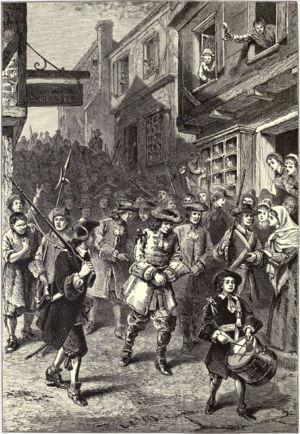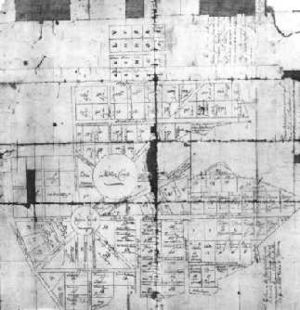Francis Nicholson facts for kids
Quick facts for kids
Francis Nicholson
|
|
|---|---|

Alleged portrait of Francis Nicholson. There are no known authentic portraits of Nicholson.
|
|
| 21st Governor of South Carolina | |
| In office 1721–1725 |
|
| Monarch | George I |
| Preceded by | James Moore II |
| Succeeded by | Arthur Middleton (acting) |
| Governor of Nova Scotia | |
| In office 1712–1715 |
|
| Monarch | Anne George I |
| Preceded by | Samuel Vetch |
| Succeeded by | Samuel Vetch |
| Governor of Virginia | |
| In office 1698–1705 |
|
| Monarch | William III Anne |
| Preceded by | George Hamilton |
| Succeeded by | Edward Nott |
| 7th Royal Governor of Maryland | |
| In office 1694–1698 |
|
| Monarch | William III |
| Preceded by | Thomas Lawrence |
| Succeeded by | Nathaniel Blakiston |
| Lieutenant Governor of Virginia | |
| In office 1690–1692 |
|
| Monarch | William III and Mary II |
| Preceded by | Nathaniel Bacon (acting) |
| Succeeded by | Sir Edmund Andros |
| Lieutenant Governor of the Dominion of New England | |
| In office 1688–1689 |
|
| Monarch | James II William III and Mary II |
| Personal details | |
| Born | 12 November 1655 Downholme, Yorkshire, England |
| Died | 5/16 March 1727/28 London, England |
| Resting place | St George's Hanover Square Church |
| Profession | Military officer, official |
| Signature | |
| Military service | |
| Allegiance | |
| Branch/service | British Army |
| Years of service | 1680-1727/28 |
| Rank | Lieutenant-General |
| Battles/wars | Monmouth Rebellion |
Lieutenant-General Francis Nicholson (1655–1728) was an important British Army general and a colonial official. He served as governor or lieutenant governor in several North American colonies. These included South Carolina, Nova Scotia, Virginia, Maryland, and the Dominion of New England.
Nicholson began his military career in Europe and Africa. He later moved to North America to support Governor Sir Edmund Andros. He became lieutenant governor of the Dominion of New England in 1688. However, after the Glorious Revolution in England, colonists rebelled. Andros was overthrown in the Boston Revolt. Nicholson also faced unrest during Leisler's Rebellion in New York. He then returned to England.
Afterward, Nicholson served as governor in Virginia and Maryland. He helped create the College of William and Mary. He also led military actions during Queen Anne's War. This included capturing Port Royal in 1710. He later became the first royal governor of Province of South Carolina. Nicholson was a strong supporter of public education and colonial unity. He died in London in 1728.
Contents
Early Life and Military Career
Francis Nicholson was born in Downholme, Yorkshire, England, on November 12, 1655. Not much is known about his early life. He started his career as a page for Charles Paulet. Paulet later helped him advance his career.
In 1678, Nicholson joined the Holland Regiment as an ensign. He fought against the French in Flanders. In 1680, he joined the 2nd Tangier Regiment. This regiment was sent to English Tangier in Africa. Nicholson showed great skill there, carrying messages between enemies and allies. This caught the attention of important officials.
In 1685, Nicholson likely helped put down Monmouth's Rebellion. He then became a captain and went to Boston in 1686. He served under Sir Edmund Andros, who was the governor of the Dominion of New England. Andros sent Nicholson on a secret mission to French Acadia. Nicholson gathered information about Port Royal's defenses. He impressed Andros and was appointed to the dominion's council.
Serving as Lieutenant Governor
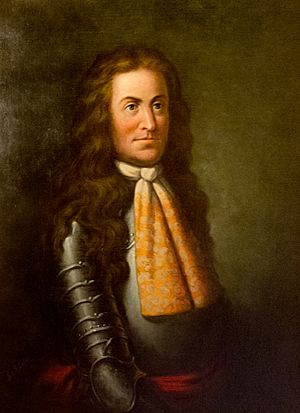
In 1688, the Dominion of New England grew to include New York and East and West Jersey. Nicholson became the dominion's lieutenant governor. He traveled with Andros to New York to take control. Many New Yorkers felt that Nicholson's rule was unfair. He believed colonists were "conquered people" and did not have the same rights as Englishmen.
Nicholson was initially seen as better than the previous governor, Thomas Dongan. However, he upset some Protestants by keeping a Catholic chapel in Fort James. In January 1689, Nicholson ordered militias to be ready to protect the colony. He did not know that big changes were happening in England.
Rebellion in Boston
In late 1688, William III and Mary II took over the English throne in the Glorious Revolution. When this news reached Massachusetts, colonists rebelled against Andros. They arrested him and other leaders in the Boston Revolt. The rebellion quickly spread, and New England colonies restored their old governments.
When news of the Boston revolt reached New York, Nicholson kept it secret. He feared a rebellion in New York. However, word reached Long Island, and colonists began to act. By mid-May, dominion officials were removed from many towns. Nicholson also learned that France had declared war on England. This meant French and Indian attacks were a threat to New York's northern border. To calm people, Nicholson invited the militia to join the army at Fort James.
New York's defenses were weak. Nicholson's council voted to add import taxes to improve them. Many merchants refused to pay. One of them was Jacob Leisler, a wealthy German merchant and militia captain. Leisler strongly opposed the dominion. He believed it was trying to force "popery" (Catholicism) on the colony. On May 22, the militia asked Nicholson for access to the fort's powder magazine. He refused, causing more fear about low powder supplies.
Rebellion in New York
On May 30, 1689, Nicholson had a heated argument with a militia officer. He said he would rather see the town burn than be commanded by the officer. Rumors spread that Nicholson planned to burn the town. The next day, Nicholson demanded the officer's resignation. Abraham de Peyster, a rich merchant and the officer's commander, argued with Nicholson. De Peyster and his brother, also a captain, then left the council.
The militia was called out and took over Fort James. They demanded the keys to the powder magazine. Nicholson eventually gave them up to prevent bloodshed. The next day, militia officers asked Jacob Leisler to lead the city militia. He agreed. The rebels declared they would hold the fort for the new monarchs until a proper governor arrived.
The militia now controlled the fort and the harbor. Ships arriving brought people directly to the fort, cutting off Nicholson's communication. On June 6, Nicholson decided to leave for England. He gathered statements to use in England. He finally sailed on June 24. Meanwhile, Leisler declared the rule of William and Mary on June 22. On June 28, a committee chose Leisler as the colony's commander-in-chief.
When Nicholson arrived in London in August, he told the king about the situation in New York. He asked to be appointed the new governor. However, the king chose Colonel Henry Sloughter instead. The king did make Nicholson lieutenant governor of Virginia.
Virginia and Maryland Roles
Nicholson served as lieutenant governor of Virginia until 1692. He helped create the College of William and Mary and was one of its first trustees. He also worked to improve the colonial militia. He approved new trade ports, which some larger merchants opposed. Nicholson believed that all colonies should be under Crown Rule for better defense.
In 1692, Lord Howard of Effingham resigned as Virginia's governor. Edmund Andros was chosen for the role, which annoyed Nicholson. This made the dislike between the two men even stronger. Nicholson was then made lieutenant governor of Maryland. He worked to have Andros removed from his post.
In 1693, Maryland Governor Sir Lionel Copley died. Andros went to Maryland to help organize things. When Nicholson arrived as the new governor in July, he found the treasury empty. He demanded that Andros return money he had been paid. Andros refused, but the Lords of Trade later ruled that Andros had to return £300.
Nicholson was a strong Anglican. He wanted to reduce Roman Catholic influence in Maryland. He moved the capital from St. Mary's City to "Anne Arundel's Town." This town was later renamed "Annapolis" in honor of Princess Anne. He designed the town's layout, placing the Anglican church and state house in public spaces. He also used diagonal avenues to connect parts of the town. Historians say Annapolis and Williamsburg, Virginia (which Nicholson also designed) are some of the best-planned towns in the British Empire.

Nicholson supported public education. He promoted laws for it and funded "King William's School." He also fought against piracy. He ordered ships going to Pennsylvania to be searched in Maryland waters. This was because Pennsylvania's governor was said to be allowing pirates to trade there. Nicholson even joined a battle against French pirate Louis Guittar in 1700. The pirates were defeated and later sentenced to hang.
Nicholson's conflict with Andros continued. Nicholson gained an ally in James Blair, who founded the College of William and Mary. Their complaints led Andros to resign. In December 1698, Nicholson became the governor of Virginia. Andros angrily refused to give Nicholson his records. Nicholson's power in Virginia was limited by a powerful council of local families. He tried to change this, even moving the capital from Jamestown to Williamsburg.

As governor of Maryland, Nicholson learned about French activities on the Mississippi River. He warned that French control of the river could harm English colonies. He suggested that governors encourage trade with Native Americans across the Appalachian Mountains. These were early warnings about the French threat. He promoted trade expansion with other colonial governors.
In 1702, Queen Anne became queen. Nicholson's political supporters lost influence. He was recalled from Virginia in 1705 and replaced by Edward Nott. He returned to London. There, he joined the Society for the Propagation of the Gospel in Foreign Parts and the Royal Society. He also advised the Board of Trade on colonial issues.
Queen Anne's War Efforts
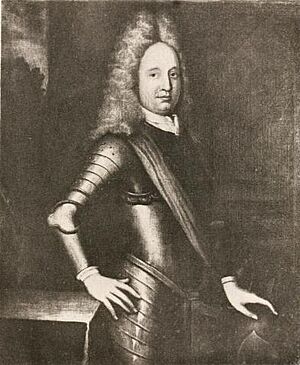
During King William's War in the 1690s, Nicholson asked Virginia to help fund New York's defense. New York was threatened by New France and protected Virginia. Virginia refused. When Queen Anne's War began in 1702, Nicholson lent New York £900 of his own money. This made him even more disliked in Virginia. Nicholson suggested that all colonies unite under one leader for defense. He was one of the first to propose uniting all North American colonies.
In 1708, Samuel Vetch, a Scottish businessman, proposed a major attack on New France. Nicholson joined the plan. It included a sea attack on Quebec and a land attack on Montreal. Nicholson led the land expedition. He gathered about 1,500 soldiers and 600 Iroquois warriors. They built camps near Lake Champlain, waiting for the fleet. However, the fleet's part in the plan was canceled. Many soldiers became sick and deserted. Nicholson learned the bad news in October.
After this failure, Nicholson returned to London. He took four Native American chiefs with him. He asked Queen Anne to lead a smaller expedition against Port Royal in French Acadia. The Queen agreed. Nicholson led the forces that captured Port Royal on October 2, 1710. This victory gave Britain permanent control over the area they called Nova Scotia. Nicholson wrote a book about this expedition. He then asked Queen Anne for another expedition to capture Quebec. This expedition, led by Admiral Hovenden Walker, failed when many ships were lost. Nicholson was very angry when he heard the news.
Governorships in Nova Scotia and South Carolina
After the failed Quebec expedition, Nicholson worked to become governor of Nova Scotia. Samuel Vetch was the governor, but his rule was not effective. Nicholson criticized Vetch's handling of the French Catholic population. In October 1712, Nicholson became governor of Nova Scotia and Placentia. He also became the auditor of all colonial accounts.
Nicholson spent only a few weeks in Port Royal in 1714. He left most of the governing to his lieutenant governor. During his time there, he argued with the Acadians. He also restricted trade between British merchants and the French. He spent most of his time in Boston, investigating Vetch's finances. Vetch called Nicholson a "malicious madman." When George I became king, Vetch cleared his name and got his post back. Nicholson was accused of neglecting the province.
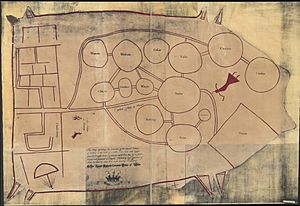
Nicholson then became the first royal governor of South Carolina (1721–1725). The colonists had rebelled against their previous rulers. Nicholson was appointed after they asked for royal control. He brought British troops with him because of threats from Native Americans. He created a council that mostly supported the rebellion. He gave them much power in colonial affairs.
He also established local governments, like those he set up in Maryland and Virginia. This included making Charleston an official town in 1722. He spent public money and his own money to support education and the Church of England. He also improved the colony's justice system. He negotiated agreements and borders with the Cherokee people. He promoted trade, similar to his policies in Maryland and Virginia. He created a commissioner of Indian affairs, a role that lasted until the 1750s.
South Carolina often had a shortage of money. They issued bills of credit to help. This caused inflation, but it became a crisis after Nicholson left. However, it angered merchants who complained about him. Nicholson returned to London in 1725 to defend himself against accusations of smuggling. He brought Cherokee baskets with him, which became part of the British Museum's first collections.
Later Life and Legacy
In England, Nicholson was promoted to lieutenant-general. He never married. He died in London on March 16, 1728. He was buried in St George Hanover Square.
Personality
Nicholson was known for his strong temper. Historians describe him as someone who could have "fits of passion." His "hasty and overmastering temper" sometimes led him to go too far.
Legacy
Nicholson Hall at the College of William and Mary is named after Francis Nicholson. Also, two main streets in Colonial Williamsburg, Francis and Nicholson, are named in his honor.
Images for kids


